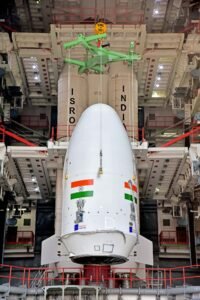On Saturday, the Indian Space Research Organisation (ISRO) achieved a successful launch of the INSAT-3DS mission into space via the heavy-lift Geosynchronous Satellite Launch Vehicle Mk-II (GSLV-MkII).
The mission, with a planned operational lifespan of 10 years, seeks to enhance India’s capabilities in environmental monitoring, oceanic observations, weather forecasting, Satellite Aided Search and Rescue Services and disaster relief efforts and Manage data collection and dissemination from Data Collection Platforms (DCPs). The launch occurred at 5:35 pm IST from the Satish Dhawan Space Centre in Sriharikota, Andra Pradesh.
After successfully launching the XPoSat mission on the first day of 2024, this marked ISRO’s second launch of the year.
What is INSAT-3DS?
 INSAT-3DS is a state-of-the-art meteorological satellite and the latest addition to India’s third-generation satellites in geostationary orbit. It follows the successful deployment of its predecessors, INSAT-3D and INSAT-3DR, which have significantly enhanced weather observation and analysis since their respective launches. INSAT-3DR has been operational since September 2016.
INSAT-3DS is a state-of-the-art meteorological satellite and the latest addition to India’s third-generation satellites in geostationary orbit. It follows the successful deployment of its predecessors, INSAT-3D and INSAT-3DR, which have significantly enhanced weather observation and analysis since their respective launches. INSAT-3DR has been operational since September 2016.
Payloads of INSAT-3DS
The payloads on ISRO’s INSAT-3DS include:
1. Imager and Sounder: Consisting of a 6-channel Imager and a 19-channel Sounder, these payloads are dedicated to advanced meteorological observations.
2. Communication Payloads: This includes crucial communication payloads such as the Data Relay Transponder (DRT).
3. Data Collection: The DRT facilitates the reception of data from automatic Data Collection Platforms and Automatic Weather Stations, enhancing weather forecasting capabilities.
4. SAS&R Transponder: The SAS&R transponder plays a vital role in relaying distress signals and alert detections from beacon transmitters, contributing to global search and rescue services.
Why GSLV F14/ INSAT-3DS also called ‘Naughty Boy’ ?
The GSLV F14 spacecraft is set to embark on its 16th mission, carrying the INSAT-3DS meteorological satellite into space. However, it has earned the moniker “naughty boy” within the Indian space program, attributed by a former chairman of ISRO. With a failure rate of 40 percent, the GSLV has encountered several setbacks in the past, experiencing issues in six out of its total 15 space missions to date. While its last mission in May 2023 was successful, the one prior to that ended in failure.
Who will be using the INSAT-3DS?
Several departments of the Ministry of Earth Sciences (MoES), including the India Meteorological Department (IMD), National Centre for Medium-Range Weather Forecasting (NCMRWF), Indian Institute of Tropical Meteorology (IITM), National Institute of Ocean Technology (NIOT), Indian National Center for Ocean Information Services (INCOIS), along with other agencies and institutes, will leverage the data from the INSAT-3DS satellite to enhance weather forecasts and meteorological services.
Next Mission of ISRO
ISRO’s next mission is the joint collaboration with NASA called NISAR, which stands for NASA-ISRO Synthetic Aperture Radar. This collaborative Earth-observing mission between NASA and the Indian Space Research Organization (ISRO) utilizes two radars, each optimized to observe a broader spectrum of changes, thereby enhancing its observational capabilities beyond what a single radar could achieve.











Comments 1